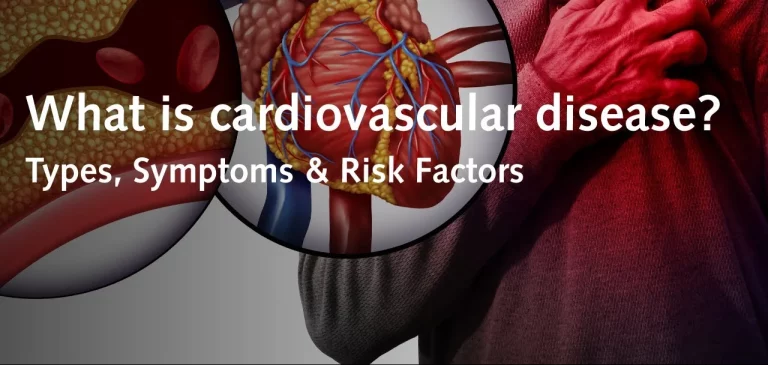
Cardiovascular Disease: Types, Symptoms, and Risk Factors
What is Cardiovascular Disease?
Cardiovascular disease (CVD) is a general term used to describe a range of conditions that affect the heart and blood vessels. CVD encompasses various disorders that can lead to serious health complications, including heart attack, stroke, and other cardiovascular events. It is one of the leading causes of morbidity and mortality worldwide.
Types of Cardiovascular Disease
1. Coronary Artery Disease (CAD)
Coronary artery disease is caused by the buildup of plaque in the coronary arteries, which supply blood to the heart muscle. This condition can lead to:
- Angina: Chest pain caused by reduced blood flow to the heart.
- Heart Attack: Occurs when a coronary artery is completely blocked, cutting off blood supply to a part of the heart muscle.
2. Hypertensive Heart Disease
Hypertensive heart disease results from prolonged high blood pressure, which can cause the heart to work harder than normal. It can lead to:
- Heart failure: The heart becomes too weak to pump blood effectively.
- Left ventricular hypertrophy: Thickening of the heart’s left ventricle due to increased workload.
3. Heart Failure
Heart failure occurs when the heart is unable to pump enough blood to meet the body’s needs. It can be caused by various heart conditions, including CAD and hypertension.
4. Arrhythmias
Arrhythmias are irregular heartbeats caused by problems with the heart’s electrical system. Types of arrhythmias include:
- Atrial fibrillation: Rapid and irregular beating of the upper chambers of the heart.
- Ventricular tachycardia: Rapid heart rate originating from the heart’s lower chambers.
5. Valvular Heart Disease
Valvular heart disease involves damage to one or more of the heart’s valves, which can affect blood flow through the heart. Types include:
- Aortic stenosis: Narrowing of the aortic valve.
- Mitral regurgitation: Leakage of blood backward through the mitral valve.
6. Cardiomyopathy
Cardiomyopathy is a disease of the heart muscle that can lead to heart failure. Types include:
- Dilated cardiomyopathy: The heart muscle becomes enlarged and weakened.
- Hypertrophic cardiomyopathy: Thickening of the heart muscle, particularly the ventricles.
7. Peripheral Artery Disease (PAD)
Peripheral artery disease occurs when arteries that supply blood to the limbs become narrowed or blocked, often leading to pain and cramping in the legs.
8. Cerebrovascular Disease
Cerebrovascular disease includes conditions that affect the blood vessels and blood supply to the brain, leading to:
- Stroke: Interruption of blood supply to the brain, causing brain damage.
- Transient ischemic attack (TIA): A temporary reduction in blood flow to the brain, often called a “mini-stroke.”
Symptoms of Cardiovascular Disease
Symptoms of cardiovascular disease can vary depending on the specific condition but often include:
- Chest pain or discomfort (angina)
- Shortness of breath
- Fatigue and weakness
- Palpitations (irregular heartbeats)
- Swelling in the legs, ankles, or feet
- Dizziness or light-headedness
- Nausea and sweating
Specific Symptoms by Condition
- Heart Attack: Intense chest pain or pressure, pain radiating to the arm, neck, or jaw, shortness of breath, nausea, and sweating.
- Stroke: Sudden numbness or weakness in the face, arm, or leg, especially on one side of the body, confusion, trouble speaking or understanding speech, and loss of balance or coordination.
- Heart Failure: Persistent coughing or wheezing, swelling in the abdomen, rapid weight gain due to fluid retention, and increased heart rate.
Risk Factors for Cardiovascular Disease
Modifiable Risk Factors
- High blood pressure (hypertension)
- High cholesterol levels
- Smoking
- Diabetes
- Obesity
- Physical inactivity
- Unhealthy diet
- Excessive alcohol consumption
- Stress
Non-Modifiable Risk Factors
- Age: Risk increases with age.
- Gender: Men are generally at higher risk, but women’s risk increases after menopause.
- Family history: A family history of CVD can increase risk.
- Ethnicity: Certain ethnic groups, such as South Asians and African Americans, have a higher risk of CVD.
Conclusion
Understanding cardiovascular disease, its types, symptoms, and risk factors is crucial for prevention and early detection. By adopting a healthy lifestyle, managing existing health conditions, and seeking regular medical advice, you can significantly reduce your risk of developing cardiovascular diseases. If you have any concerns about your heart health, do not hesitate to contact London Private Ultrasound for a comprehensive cardiovascular assessment.
To book online select the date and time that suits you best – alternatively, please contact us with any questions via the chat, call or email links provided.
Telephone: 020 7101 3377

